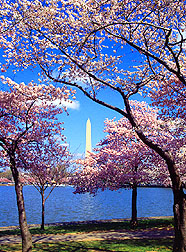This page has been archived and is being provided for reference purposes only. The page is no longer being updated, and therefore, links on the page may be invalid.
Historic Cherry Trees from Japan Given New Life
By Jill Lee
March 24, 1999
WASHINGTON, March 24–With a gift of 500 very special saplings, Agriculture Secretary Dan Glickman today helped ensure the survival of a national treasure, Washington’s historic cherry blossoms.
The saplings were grown from cuttings off the original Yoshino cherry trees Japan gave the United States as a token of friendship in 1912.
Glickman presented the saplings to Interior Secretary Bruce Babbitt to help the National Park Service continue the cherry blossom tradition along the Tidal Basin as the original cherry trees age and die.
“I am so pleased that USDA could contribute to the preservation of this historic legacy for the American people,” said Glickman. “The annual blossoming of these fragrant trees is a Washington rite of spring. It symbolizes not only our friendship with Japan, but our love for the outdoors.”
Only 125 of the original 3,000 cherry trees remain. Yoshino cherry trees live an average of 47 years, yet the trees along the Tidal Basin are now 87 years old. Many of the remaining trees are dying of old age. To prevent their complete loss, scientists from the U.S. National Arboretum, part of USDA’s Agricultural Research Service, grew cuttings from the historic trees around the Tidal Basin. The new trees will help the National Park Service maintain the genetic lineage of the original trees.
“I accept these trees on behalf of the National Park Service and the American people,” said Babbitt. “This unique effort is in step with the President’s approach to restore and preserve green space for Americans to enjoy. The nation’s capital will always be known for its beautiful cherry blossoms in the spring, but the preservation of the original Yoshino cherry trees in the spirit of Japanese friendship is a very special achievement.”
When the saplings, genetic copies of the original trees, are old enough, they will be planted around the Tidal Basin and in Washington’s East and West Potomac Parks.
USDA scientists at the National Arboretum are studying the historic Yoshino trees as part of their ongoing efforts to improve disease and pest resistance in ornamental and fruit cherry trees.
The arboretum's cherry research is the cover story of the April issue of ARS's Agricultural Research magazine. The story also is on the World Wide Web at:
/is/AR/archive/apr99/cher0499.htm
This year's National Cherry Blossom Festival is scheduled for March 28-April 11. Thousands of visitors are expected during the cherry trees' limited period of full bloom. The National Park Service posts its current prediction of when the cherry trees will be in full bloom on the web at:
http://www.nps.gov/nacc/cherry
Scientific contact: Margaret Pooler or Ruth Dix, ARS U.S. National Arboretum, phone (202) 245-4568 (Pooler), (202) 245-4762 (Dix); fax (202) 245-4575; mpooler@ars-grin.gov, DixR@ars.usda.gov.

